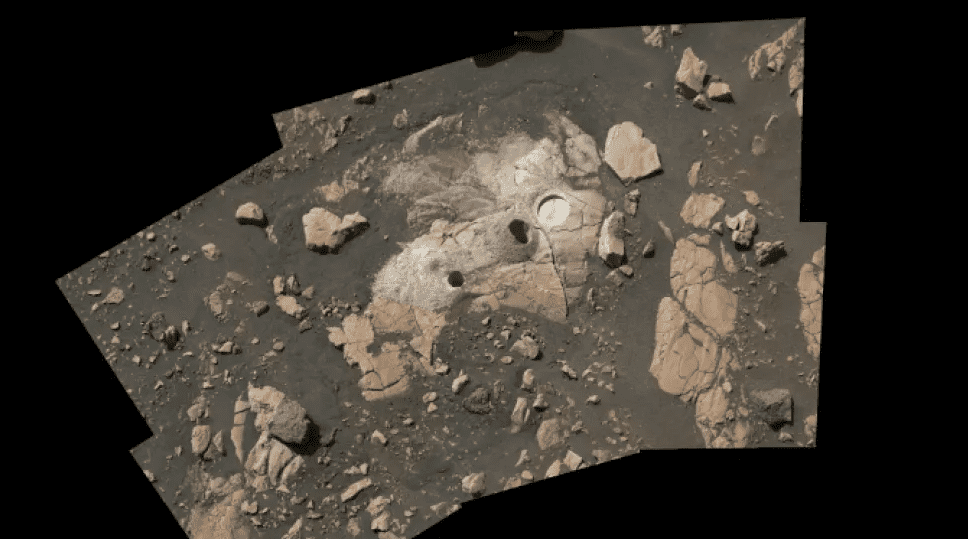With Perseverance comes reward; the rover has collected four samples from an ancient river delta on Mars that are richly packed with organic materials, according to NASA. The discovery brings us one step closer to determining whether ancient Mars harbored life.

Perseverance has been hard at work the past few months exploring Mars for signs of ancient life. Its effort has focused on the ancient floor of Jezero Crater, which housed a sprawling river delta billions of years ago. And new findings suggest that mission control was right in choosing this site to send the rover to. Four samples collected in this formation since early July show remains of organic material.
All four samples show that this part of Mars could have supported Earth-like organisms in the planet’s ancient past, meaning that if microbial life ever spawned on Mars, there’s a high chance we’ll find traces of it in this area.
Organic red
“The rocks that we have been investigating on the delta have the highest concentration of organic matter that we have yet found on the mission,” Perseverance project scientist Ken Farley, of the California Institute of Technology in Pasadena, said during a press conference on Thursday.
“And of course, organic molecules are the building blocks of life. So this is all very interesting, in that we have rocks that were deposited in a habitable environment in a lake which carry organic matter.”
One of the structures that Perseverance recently sampled and analyzed is a 3-foot-wide (0.9 meters) rock that the ground team knows as Wildcat Ridge. The results here are particularly intriguing; this formation is made up of fine-grained mudstones that formed at the bottom of the ancient Jezero lake. The rover’s SHERLOC (Scanning Habitable Environments with Raman and Luminescence for Organics and Chemicals) instrument found high levels of organic materials inside the sample from Wildcat Ridge, associated with sulfur-containing minerals called sulfates.
“This correlation suggests that, when the lake was evaporating, both sulfates and organics were deposited, preserved and concentrated in this area,” SHERLOC scientist Sunanda Sharma, of NASA’s Jet Propulsion Laboratory in Southern California, said during Thursday’s press conference.
Down here on Earth, sulfate deposits can often conserve organic material, acting as time capsules of signs of life (“biosignatures”). Because of this, Sharma considers the results from this sample some of the most intriguing sets from the whole mission so far and grounds for great excitement.
For now, however, the presence of organic material in these samples doesn’t mean that we’ve found martian biosignatures. Organic molecules can be generated and moved through completely abiotic, geological processes. The data we have so far on the Jezero delta isn’t sufficient for us to understand the context these organic materials existed and formed in. Publicly claiming that we’ve finally found alien life would be a huge event, so the team is extremely cautious to be sure of this conclusion and to gather undeniable proof to support their claim before making such a determination. It is, then, exceedingly likely that the samples Perseverance collected will need to be brought back home for more research before any conclusion is drawn.
If all goes according to plan, the samples will be returned to Earth around 2033 by a joint NASA-European Space Agency (ESA) mission. After they reach Earth, researchers around the world will analyze them with every instrument available, most of which will be more powerful than what the Perseverance rover could be equipped with.
Out of the rover’s 43 sample tubes, 15 have already been filled and sealed. Out of these, 12 contain rock cores, 1 is an atmospheric sample that was produced during Perserverence’s first attempt to drill a rock sample, and 2 are “witness” tubes. These will be used as controls to determine if contaminants from Earth made it into the Mars samples.
Just in case something happens to Perseverance before it can deposit its samples with the return mission, NASA and ESA do have a backup plan. The rover collected two samples from every site it drilled down into, one of which it keeps on board, and the other deposited in one of several caches on Jezero’s floor. If something happens to Perseverance, the ESA-NASA lander will touch down near the caches and use two helicopters to recover the tubes. Both of these helicopters are based on and very similar to Ingenuity, the helicopter that accompanies Perseverance on Mars and has already completed 31 successful flights.
Ground team has already selected a candidate spot for one of the caches, a flat part of Jezero’s floor that would be safe for a craft to land down on. They will be deciding whether to go forward with this spot in the following month. If they give the green light, Perseverance will deposit 10 to 11 sample tubes at the site, which will take around two months to complete.






